Some Applications of Trigonometry Class 10th Notes - Free NCERT Class 10 Maths Chapter 9 Notes - Download PDF
Learn how heights and distances become easy with Trigonometry tricks! The real world uses trigonometry for measuring angles, together with distances and heights, without physical access to objects. Various professional fields, such as architecture, civil engineering, navigation, astronomy, together with computer graphics design, make extensive use of trigonometric methodologies. Every modern structure or astronomical operation depends on basic trigonometric equations as its foundation. These revision notes present vital formulas combined with actual examples, together with essential concepts to help solve problems efficiently. The correct approach, along with clarity, turns trigonometry into a smart and organised method for addressing real-world problems in both academic settings and actual situations. These NCERT Notes for Class 10 Maths are trustworthy and reliable, as they are created by subject matter experts at Careers360, making them an essential resource for exam preparation.
This Story also Contains
- Class 10 Some Applications of Trigonometry Notes PDF – Download Free Study Material
- Some Applications of Trigonometry Class 10 Notes
- How to Use the Some Applications of Trigonometry Class 10 Notes Effectively?
- Some Applications of Trigonometry Class 10 Notes: Previous Year Question and Answer
- NCERT Class 10 Maths Notes – Chapter-Wise Links
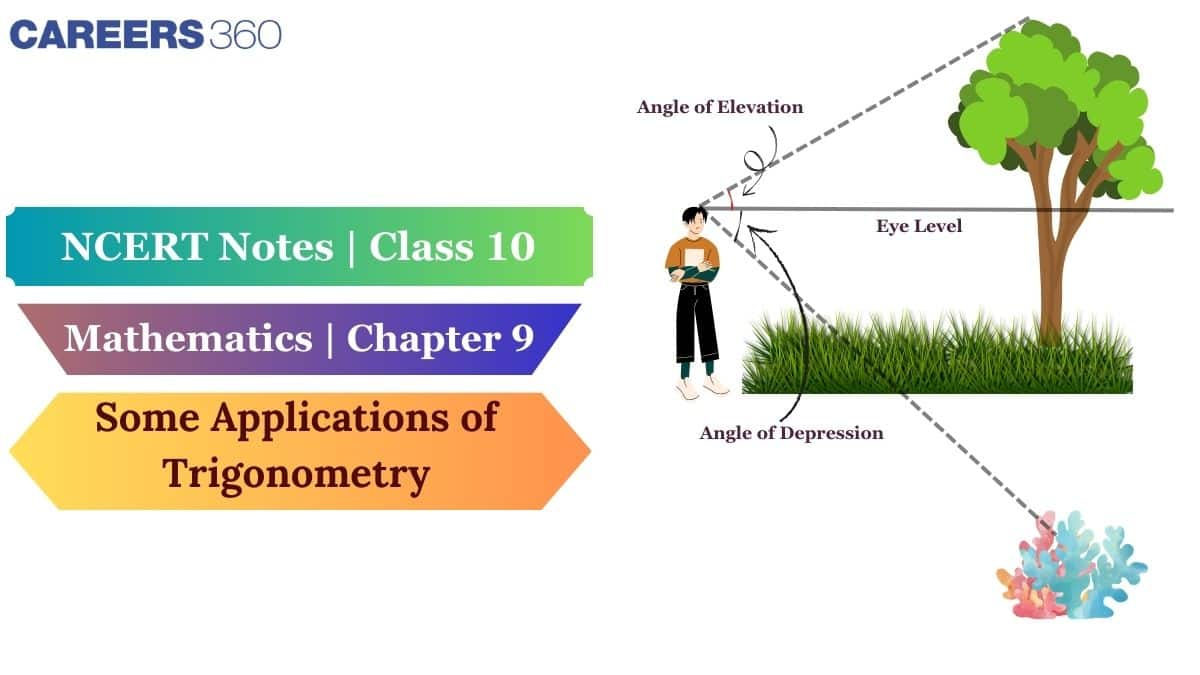
This chapter presents a study of how trigonometric principles apply in fact-based conditions. Students must practice all the topics of Trigonometry and their examples from the NCERT Exemplar. These NCERT notes can be very effective before appearing in the exams when time is less, and students need to cover the important concepts one last time to feel fully confident. Explore NCERT Books, Solutions, Syllabus, and Exemplar Problems with Solutions for complete syllabus coverage in this NCERT article.
Class 10 Some Applications of Trigonometry Notes PDF – Download Free Study Material
Students who wish to access the Some Applications of Trigonometry Class 10 Maths notes can click on the link below to download the entire notes in PDF.
Some Applications of Trigonometry Class 10 Notes
Careers360 experts have curated these Some Applications of Trigonometry Class 10 Notes to help students revise quickly and confidently.
Line of Sight
Observers create an imaginary straight line that extends from their eyes toward the viewed object. The study of trigonometry requires this tool because it enables users to identify angles at specific observational heights.
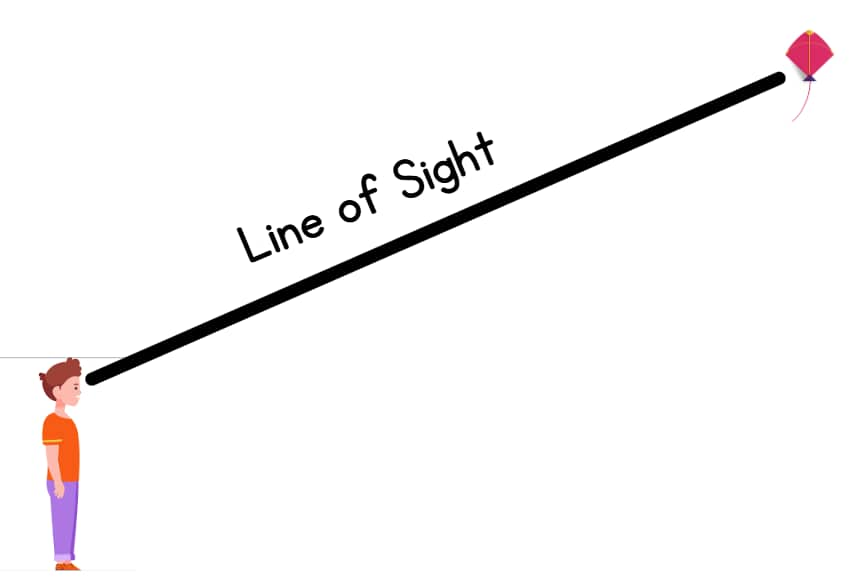
Horizontal line
The horizontal line represents an invisible straight path which runs parallel to the ground, starting from the viewer's eye level. A horizontal line establishes a reference for trigonometry to measure the angles of elevation and depression.
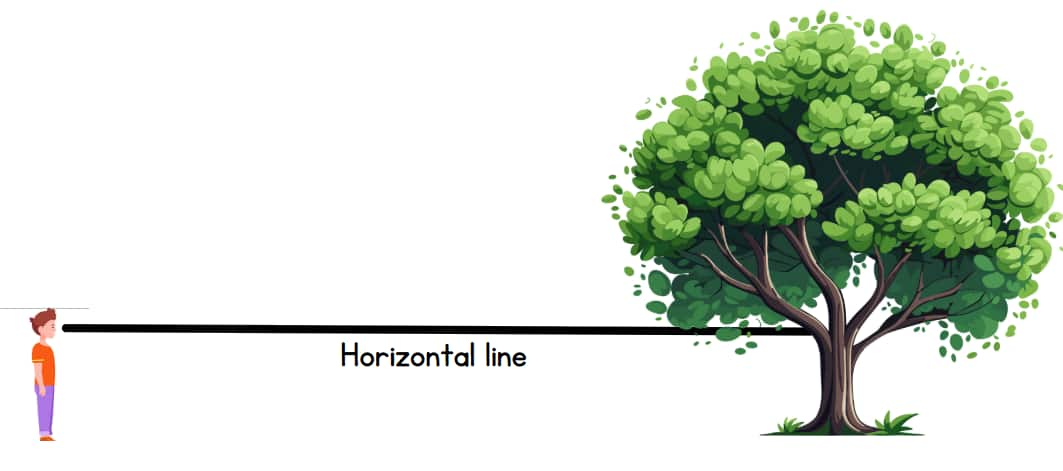
Angle of Elevation
An observer who looks up toward an object will experience this phenomenon. To determine the measurement, the angle formed between the sightline and the eye-level horizontal line.
For Example, if a person looks at the top of a tree, the angle formed between their line of sight and the horizontal line is the angle of elevation.
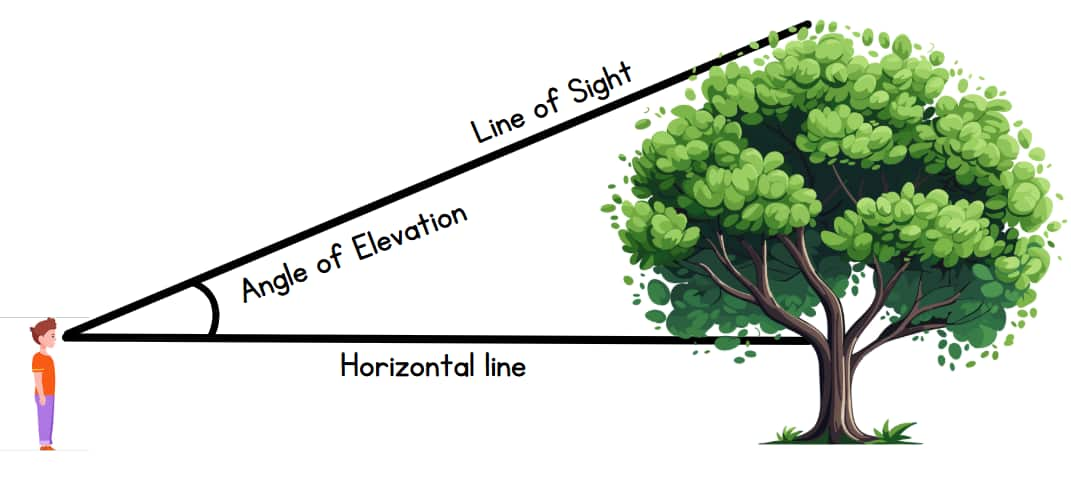
Angle of Depression
An observer who looks down toward an object will experience this phenomenon. To determine the measurement, the angle formed between the sightline and the eye-level horizontal line.
For Example, if you are standing on a cliff and looking at a boat in the sea, the angle between your line of sight and the horizontal line at your eye level is the angle of depression.
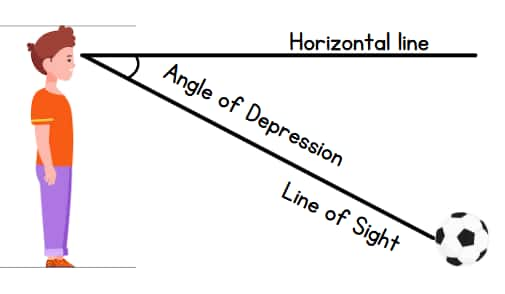
Height and Distance Problems Using Trigonometry
The application of trigonometric ratios enables the solution of problems regarding the measurement of height and distance. The following key sequence directs a solution to these problems:
- Spot the right-angled triangle present in the provided problem.
- Identify known along with unknown values of height, distance and angle in this problem.
- Select the appropriate trigonometric ratio according to the available information.
- Solve for the unknown value.
Case 1: When the Angle of Elevation is known:
- The observer looks up towards an object.
- The height of the object and the horizontal distance form a right-angled triangle.
- Use the Trigonometric ratios accordingly.
For example, A tower is 30 meters high. The angle of elevation of the top of the tower from a point on the ground is 60°. Find the distance of the point from the base of the tower.
Solution: Given:
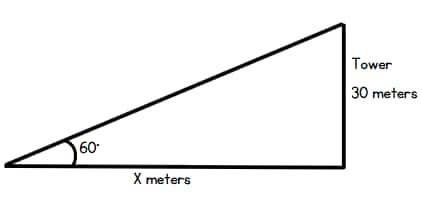
- Height of tower (Perpendicular) = 30 m
- Angle of elevation = 60°
- Distance of the point from the base (Base) = x
Using the formula:
tan θ = $\frac{\text{Perpendicular}}{\text{Base}}$
⇒ tan 60° = $\frac{30}{x}$
⇒ $\sqrt 3$ = $\frac{30}{x}$
⇒ x = $\frac{30}{\sqrt3}$
⇒ x = 10√3 m ≈ 17.32 m
Case 2: When the Angle of Depression is known:
- The observer looks down towards an object.
- The height of the object and the horizontal distance form a right-angled triangle.
- Use the Trigonometric ratios accordingly.
For example, A lighthouse stands on a cliff 50 meters above sea level. A boat is spotted at sea, and the angle of depression from the top of the lighthouse to the boat is 30°. Find the distance of the boat from the base of the cliff.
Solution: Given:
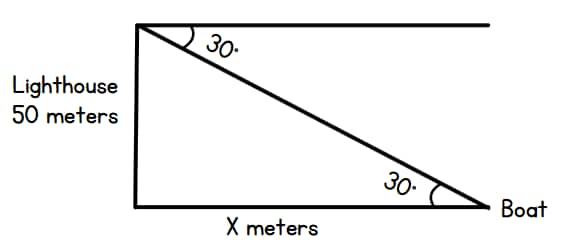
- Height of lighthouse (Perpendicular) = 50 m
- Angle of depression = 30°
- Distance of boat from the base of the cliff (Base) = x
Using the formula:
tan θ = $\frac{\text{Perpendicular}}{\text{Base}}$
⇒ tan 30° = $\frac{50}{x}$
⇒ $ \frac{1}{\sqrt3} = \frac{50}{x}$
⇒ x = 50√3 ≈ 86.6 meters
How to Use the Some Applications of Trigonometry Class 10 Notes Effectively?
This chapter is all about using trigonometry in real life, like finding heights and distances without actually measuring them. If you understand the basics, solving these questions becomes much easier. These Class 10 Maths chapter 9 notes can help you revise and practise quickly. Here are some more points on how these notes are important.
- Start by understanding how angles and trigonometric ratios are used in real-world situations before moving on to questions.
- Draw rough diagrams for each problem to visualise heights, distances, and angles clearly.
- These concepts are also helpful in higher classes and competitive exams, so practising from the NCERT Class 10 Maths chapter 9 notes will strengthen your base.
- Use the NCERT Class 10 Maths chapter 9 notes while solving exercise questions to learn step-by-step methods and avoid confusion.
Some Applications of Trigonometry Class 10 Notes: Previous Year Question and Answer
Listed below are important previous year question answers for NCERT Class 10 Maths Chapter 9 Some Applications of Trigonometry compiled from different board exams.
Question 1:
A tree of height $h$ metres is broken by a storm in such a way that its top touches the ground at a distance of $x$ metres from its root. Find the height at which the tree is broken. (Here $h>x$)
Solution:
Given:
AB = Height of tree = $h$ metre
Let the height at which the tree is broken, AC = $y$ metres
BC = CD = Broken part of tree = $(h – y)$ metre
∴ In ∆ ACD,
AC2 + AD2 = CD2
⇒ $y^2 + x^2 = (h – y)^2$
⇒ $y^2 + x^2 = h^2 + y^2 – 2hy$
⇒ $x^2 = h^2 – 2hy$
⇒ $2hy = h^2 – x^2$
$\therefore y =\frac{h^2-x^2}{2h}$ metre
Hence, the correct answer is $\frac{h^2-x^2}{2h}$ metres.
Question 2:
Subhas, a 3.15 m tall tree, and an 11.25 m tall building are positioned such that their feet on the ground are collinear and the tree is located between Subhas and the building. The tree is located at a distance of 7.5 m from Subhas and a distance of 45 m from the building. Further, the eyes of Subhas, the top of the tree, and the top of the building fall in one line. Find the height (in m ) from the ground at which Subhas's eyes are situated.
Solution:
Let XA be Subhas, YB be the tree, and ZC be the building.
YB = 3.15 m
ZC = 11.25 m
AB = 7.5 m
BC = 45 m
XO = AB = 7.5 m
OP = BC = 45 m
⇒ XP = XO + OP = 7.5 + 45 = 52.5 m
Let the height from the ground at which Subhas's eyes are situated be $h$.
OY = BY – OB = 3.15 – $h$
PZ = ZC – PC = 11.25 – $h$
Let the angle of elevation be $\theta$.
In $\triangle$XPZ, $\tan \theta = \frac{\text{PZ}}{\text{PX}} = \frac{11.25-h}{52.5}$ -----------(i)
In $\triangle$XOY, $\tan \theta = \frac{\text{OY}}{\text{OX}} = \frac{3.15-h}{7.5}$ ------------(ii)
$⇒ \frac{11.25-h}{52.5} = \frac{3.15-h}{7.5}$
$⇒ \frac{11.25-h}{7} = \frac{3.15-h}{1}$
$⇒11.25-h = 7(3.15-h)$
$⇒11.25-h = 22.05-7h$
$⇒6h = 10.8$
$\therefore h = \frac{10.8}{6} = 1.8$ m
Hence, the correct answer is 1.8.
Question 3:
The angle of elevation of the top of a building at a distance of 70 m from its foot on a horizontal plane is found to be 60°. Find the height of the building.
Solution:
Height = AC
We know, $\tan \theta=\frac{\text{Perpendicular}}{\text{Base}}$
⇒ $\tan60° =\frac{AC}{70}$
⇒ $\sqrt3=\frac{AC}{70}$
⇒ $AC=70\sqrt3\text{ m}$
Hence, the correct answer is $70\sqrt3\text{ m}$.
NCERT Class 10 Maths Notes – Chapter-Wise Links
We at Careers360 compiled all the NCERT class 10 Maths notes in one place for easy student reference. The following links will allow you to access them.
NCERT Exemplar Solutions for Class 10
Students must check the NCERT Exemplar solutions for class 10 of Mathematics and Science Subjects.
NCERT Solutions for Class 10
Students must check the NCERT solutions for class 10 of Mathematics and Science Subjects.
NCERT Books and NCERT Syllabus
Before the start of a new academic year, students should refer to the latest syllabus to determine the chapters they’ll be studying. Below are the updated syllabus links, along with some recommended reference books.
Frequently Asked Questions (FAQs)
Some key applications include:
- Architecture & Engineering: Designing buildings, bridges, and roads.
- Aviation & Navigation: Calculating flight paths, ship distances, and altitudes.
- Astronomy: Measuring distances between celestial bodies.
- Surveying: Mapping land and measuring terrain.
- Physics & Mechanics: Understanding wave motion, oscillations, and forces.
Trigonometric ratios and the angle of elevation are used to determine a tower's height:
1. Identify the given values:
- The angle of elevation (θ).
- The distance (base) from the observer to the base of the tower.
2. Use the trigonometric ratios.
tanθ = Height of TowerBase Distance
3. Substitute values and calculate.
Angle of Elevation (θ): The angle formed between the horizontal line and the line of sight when a person is looking in an upward direction.
Angle of Depression (θ): The angle formed between the horizontal line and the line of sight when a person is looking in a downward direction.
Distances that are challenging to measure directly can be measured using trigonometry, including:
- Employing angles of elevation to determine a mountain's height.
- Angles of depression are used to calculate the distance between two ships.
- How high an airplane is above the ground.
We can determine unknown distances by using the trigonometric ratios (sin, cos, and tan).
- Create a diagram that illustrates the issue.
- Label the known values and locate the right-angled triangle.
- Select either the sin, cos, or tan trigonometric ratio.
- Enter the provided values in the formula.
- Find the value that is unknown.
Courses After 12th
Applications for Admissions are open.
As per latest syllabus. Physics formulas, equations, & laws of class 11 & 12th chapters
JEE Main Important Chemistry formulas
Get nowAs per latest syllabus. Chemistry formulas, equations, & laws of class 11 & 12th chapters
JEE Main high scoring chapters and topics
Get nowAs per latest 2024 syllabus. Study 40% syllabus and score upto 100% marks in JEE
JEE Main Important Mathematics Formulas
Get nowAs per latest syllabus. Maths formulas, equations, & theorems of class 11 & 12th chapters



